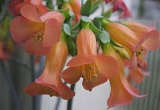
Kalanchoe delagoensis
Encyclopedia
Kalanchoe delagoensis is a succulent plant
native to Madagascar
. In common with the other members of the Bryophyllum section
of the genus
Kalanchoe
, K. delagoensis is notable for vegetatively growing small plantlets on the fringes of its leaves, leading to its common names of mother of thousands and mother of millions. Chandelier plant is an alternative common name.
The plant's capability for vegetative reproduction
, its resistance to drought
, and its popularity as a garden plant
, have allowed the plant to become an invasive weed in places such as eastern Australia and many Pacific islands
. In the Neotropics it even gets pollinated by hummingbird
s on occasion.
As well as displacing native plants, K. delagoensis is also unwelcome because it contains bufadienolide cardiac glycosides which can cause cardiac poison
ing, particularly in grazing animals. During 1997, 125 head of cattle died after eating mother-of-millions on a travelling stock reserve near Moree, NSW.
Succulent plant
Succulent plants, also known as succulents or fat plants, are water-retaining plants adapted to arid climates or soil conditions. Succulent plants store water in their leaves, stems, and also in roots...
native to Madagascar
Madagascar
The Republic of Madagascar is an island country located in the Indian Ocean off the southeastern coast of Africa...
. In common with the other members of the Bryophyllum section
Section (botany)
In botany, a section is a taxonomic rank below the genus, but above the species. The subgenus, if present, is higher than the section, and the rank of series, if present, is below the section. Sections are typically used to help organise very large genera, which may have hundreds of species...
of the genus
Genus
In biology, a genus is a low-level taxonomic rank used in the biological classification of living and fossil organisms, which is an example of definition by genus and differentia...
Kalanchoe
Kalanchoe
Kalanchoe , also written Kalanchöe or Kalanchoë, is a genus of about 125 species of tropical, succulent flowering plants in the Family Crassulaceae, mainly native to the Old World but with a few species now growing wild in the New World following introduction of the species.Most are shrubs or...
, K. delagoensis is notable for vegetatively growing small plantlets on the fringes of its leaves, leading to its common names of mother of thousands and mother of millions. Chandelier plant is an alternative common name.
The plant's capability for vegetative reproduction
Vegetative reproduction
Vegetative reproduction is a form of asexual reproduction in plants. It is a process by which new individuals arise without production of seeds or spores...
, its resistance to drought
Drought tolerance
Drought tolerance refers to the degree to which a plant is adapted to arid or drought conditions. Desiccation tolerance is an extreme degree of drought tolerance...
, and its popularity as a garden plant
Ornamental plant
Ornamental plants are plants that are grown for decorative purposes in gardens and landscape design projects, as house plants, for cut flowers and specimen display...
, have allowed the plant to become an invasive weed in places such as eastern Australia and many Pacific islands
Pacific Islands
The Pacific Islands comprise 20,000 to 30,000 islands in the Pacific Ocean. The islands are also sometimes collectively called Oceania, although Oceania is sometimes defined as also including Australasia and the Malay Archipelago....
. In the Neotropics it even gets pollinated by hummingbird
Hummingbird
Hummingbirds are birds that comprise the family Trochilidae. They are among the smallest of birds, most species measuring in the 7.5–13 cm range. Indeed, the smallest extant bird species is a hummingbird, the 5-cm Bee Hummingbird. They can hover in mid-air by rapidly flapping their wings...
s on occasion.
As well as displacing native plants, K. delagoensis is also unwelcome because it contains bufadienolide cardiac glycosides which can cause cardiac poison
Poison
In the context of biology, poisons are substances that can cause disturbances to organisms, usually by chemical reaction or other activity on the molecular scale, when a sufficient quantity is absorbed by an organism....
ing, particularly in grazing animals. During 1997, 125 head of cattle died after eating mother-of-millions on a travelling stock reserve near Moree, NSW.

